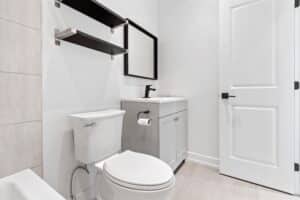Experiencing low water pressure can be frustrating, especially when it disrupts daily activities like showering, washing dishes, or doing laundry. If you’re wondering, “Why is my water pressure low?” here are seven possible reasons to consider.
1. Clogged Pipes
Over time, mineral deposits, rust, or debris can build up inside your pipes, narrowing the passageway and reducing water flow. This is particularly common in older homes with galvanized steel pipes.
Solution: A plumber can inspect your pipes and, if necessary, clean or replace them to restore normal water pressure.
2. Leaking Pipes
Leaks in your plumbing system can cause a drop in water pressure, as water escapes before reaching your fixtures. Leaks can occur anywhere along your water lines, including hidden areas behind walls or under floors.
Solution: If you suspect a leak, it’s essential to have a professional locate and repair it to prevent further damage and restore proper water pressure.
3. Faulty Pressure Regulator
A pressure regulator (or pressure-reducing valve) is designed to maintain a consistent water pressure in your home. If this device fails, it can cause the pressure to drop significantly.
Solution: Replacing a faulty pressure regulator is usually a straightforward fix that can restore your water pressure to normal levels.
4. Municipal Water Supply Issues
Sometimes, the issue isn’t within your home but with the municipal water supply. If your neighbors are also experiencing low water pressure, it could be due to maintenance work, a broken water main, or high demand in your area.
Solution: Contact your local water supplier to confirm if there’s an issue on their end. If so, they should be able to provide an estimated time for resolution.
5. Partially Closed Valves
Your home’s water supply has several valves that control the flow of water. If any of these valves are partially closed, it can restrict water flow and reduce pressure throughout your home.
Solution: Check the main shut-off valve and any other valves in your system to ensure they are fully open.
6. Water Heater Issues
If you notice low water pressure only when using hot water, the problem might be with your water heater. Sediment buildup inside the tank or issues with the heater’s components can restrict water flow.
Solution: Flushing the water heater to remove sediment or having it serviced by a professional can often resolve this issue.
7. Shared Pipelines
In some cases, multiple homes or units may share a single water supply line. If your neighbors are using a lot of water at the same time, it can lead to lower pressure in your home.
Solution: If this is the case, installing a water pressure booster pump can help maintain consistent pressure, even when demand is high.
Conclusion
Low water pressure can stem from various issues, ranging from minor valve adjustments to more significant plumbing problems. By identifying the cause of the low pressure, you can take the appropriate steps to fix it and restore your home’s water flow. Whether it’s a simple DIY fix or requires a professional plumber, addressing the issue promptly will help ensure you have reliable water pressure throughout your home.

